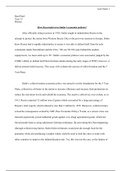Last Name 1
Raul Patel
Year 13
History
How Successful were Stalin’s economic policies?
After officially rising to power in 1928, Stalin sought to industrialize Russia in the
attempt to protect the nation from Western threats. Due to the post-war tensions in Europe, Stalin
knew Russia had to rapidly industrialize to ensure it was able to defend itself from the anti-
communist ideals from Britain and the USA. “We are 50-100 years behind the modern
superpowers, we must catch up in 10”. Stalin’s economic policies were successful, judged by the
USSR’s ability to defend itself from German attacks during the early stages of WW2, however, it
did not present initial success. This essay will evaluate the success of collectivization and the 5
Year Plans.
Stalin’s collectivization economic policy was aimed to set the foundations for the 5 Year
Plans, collectivize all farms in the nation to increase efficiency and increase food production (to
reduce the starvation levels and rebuild the economy. The need to collectivize was evident, as in
1913, Russia exported 12 million tons of grain (which accounted for a large percentage of
Russia’s total exports, which reduced to less than 2 million by 1922. Moreover, collectivization
solved the consequences created by NEP (New Economic Policy) *Lenin, as a scissor crisis was
formed (expensively priced industrial goods against very cheap agricultural goods, which led
forced people back to using subsistence farming techniques. By preventing this from happening
(through collectivizing farms), Stalin believed farmers would provide enough food for the
peasantry while also producing a surplus which could be used to feed the cities or trade with
other countries to improve the industrialization rate. Yet, this was not the case, as the famine of





